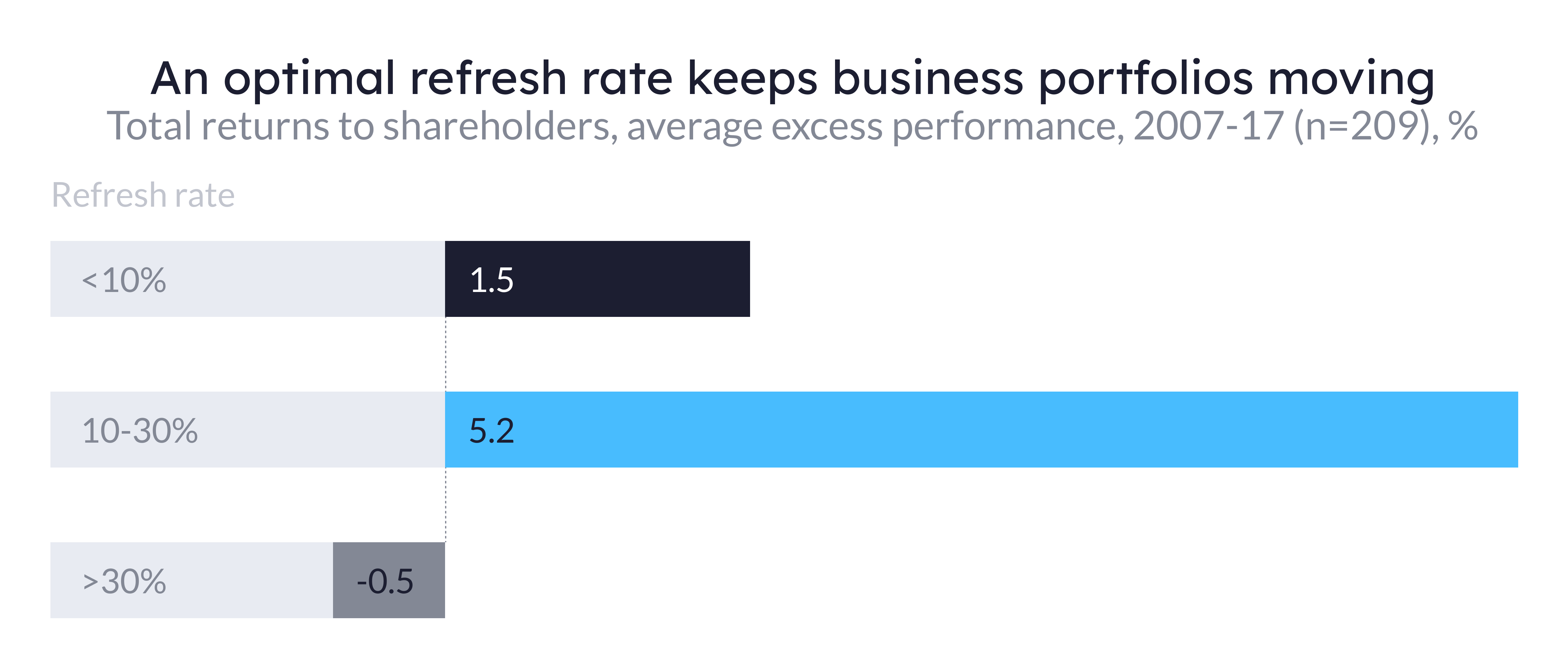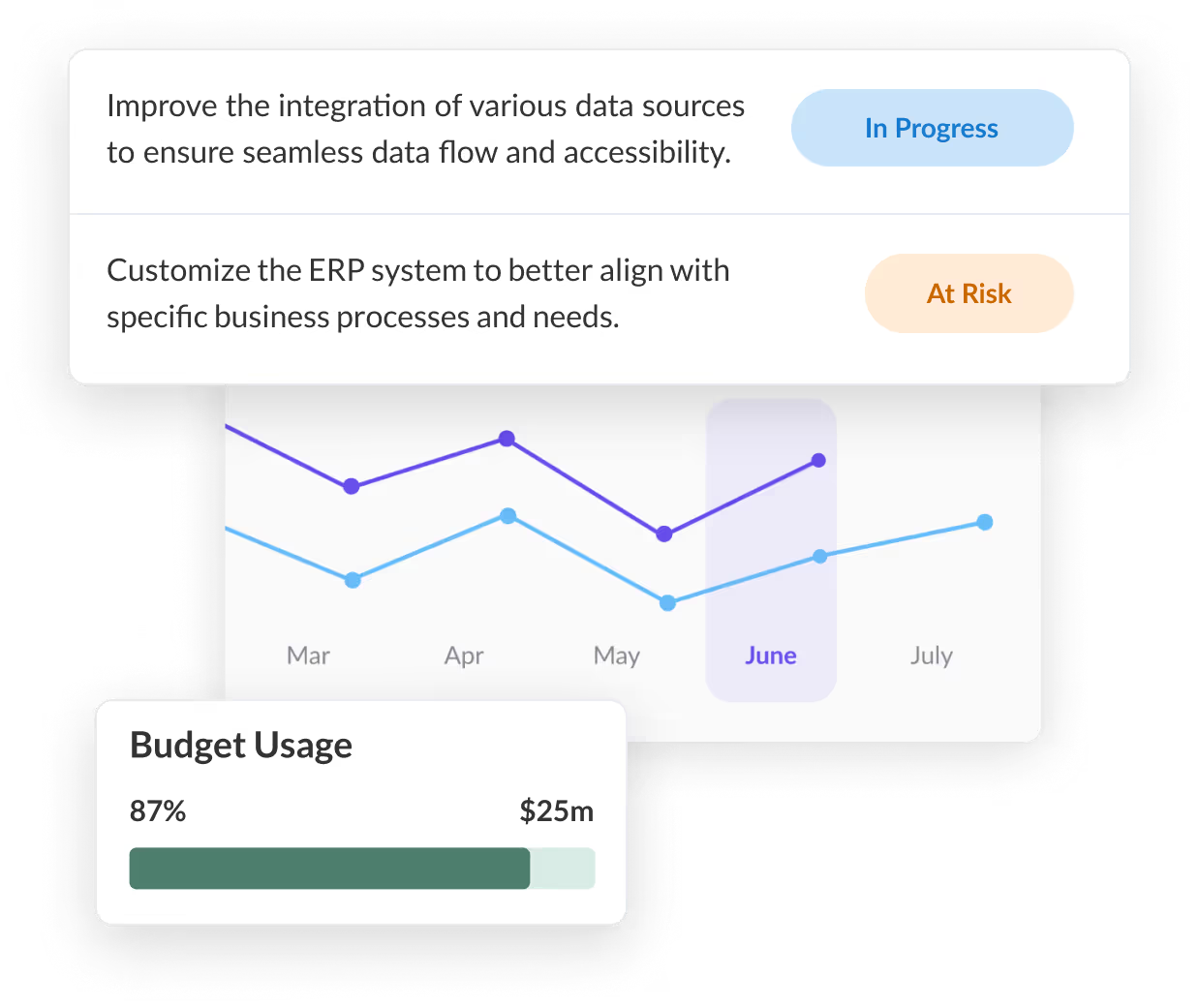It’s that time of the quarter again. The portfolio review begins. Countless slides circulate across the boardroom. Leadership discusses metrics and approves plans. The process feels rigorous, almost scientific. Yet, you know that by the time decisions reach implementation, the market will already have shifted.
The data tells a clear story: companies that consistently refresh their business mix outperform their competitors by 3.5% in total shareholder return over the long term. The formula appears straightforward — develop, acquire, or divest businesses and products to execute strategy. Still, most organizations approach portfolio management as if markets would freeze between annual planning cycles.
This disconnect reveals a disregard for the fundamental change in the enterprise landscape. Innovation adoption curves that once spanned over years now compress into months. Competitive advantages that lasted years now disappear in quarters, and strategic windows that once stayed open long enough for deliberate planning now close before annual budgets are even finalized.
Markets now evolve faster than most resource allocation programs can adapt. The portfolio that once secured your competitive advantage may now be holding you back. The real question for leaders in 2026: Can your portfolio management keep up with the rate of change in your industry?
Traditional Business Portfolio Management Is Breaking Down
Executives recognize the pace of change around them. In 2020, 49% claimed to expect to make the most considerable investments in technology advancements. So, if not a lack of awareness, what is the reason behind slow adaptation?
What shapes the delay in response is the process of portfolio management itself. Most systems were originally designed for predictability and efficiency under stability, meaning annual cycles, fixed budgets, and governance focused on (cost) control. Teams plan twelve months ahead while markets shift every twelve weeks; Budgets guide decisions even after assumptions evolve; And metrics highlight completion instead of contribution. The bottom line: the same structures that once created stability now hinder change.
The effects are visible across industries. In a recent McKinsey survey, 77% of leaders said they delayed critical portfolio decisions, often waiting too long to reallocate or stop underperforming initiatives. These delays trap capital and talent in projects where potential has already faded, while high-priority initiatives compete for attention and resources they never receive. As a result, less than half (42 percent) of organizations report high alignment of initiatives to organizational strategy.
A Tale of Two Giants
One of the best examples of portfolio discipline affecting competitive dynamics is the contrast between Microsoft and IBM in cloud computing. Both saw the opportunity, but their choices led to very different outcomes.
Despite only entering the cloud market in 2012, Microsoft built a cloud business worth around $35 billion, and in 2018, it already boasted a 17% market share. At IBM, the story was different. Even with a head start of 5% market share in 2012, the company grew that share to only 7% in 2018.
The difference lay in resource commitment and the willingness to rotate the portfolio toward high-potential playing fields. Microsoft accelerated while IBM hesitated, and that cost billions in market position.
The Five Signs of Failing Business Portfolio Management
These missteps manifest in specific, recurring patterns. Organizations operating with declining portfolio management approaches encounter the same obstacles repeatedly, each one building upon the others. Recognizing these signs helps executives understand where their own systems might be vulnerable.
1. Misaligned Project Funding
A 2024 analysis found that 44% of projects fail due to poor alignment between business objectives and project goals. It’s a clear sign of failing portfolio performance: funding decisions rely on habit instead of evidence, measurability remains limited, and capital remains tied to low-impact work. As a result, the initiatives that could drive real outcomes struggle to get attention.
Customer example: A leading global logistics provider used Workpath to connect strategic objectives with measurable key results across its European organization. Previously unmeasurable projects became trackable, enabling faster decisions and greater transparency across strategic initiatives. Read the case study here.
2. Lack of Predictive Planning
Effective portfolio management depends on foresight. Many companies still plan reactively, adjusting only after results materialize instead of anticipating them. Leading organizations, however, model funding scenarios weekly, adjusting portfolio allocation as new data emerges. If you cannot simulate portfolio changes, you cannot steer effectively. Decision-makers who rely on static spreadsheets often respond too late, missing the moment when decisive action could create the most impact.
3. Slow and Static Reviews
Many portfolio reviews still rely on manual reporting and extensive documentation. But the countless PowerPoint files with status updates are only a symptom of a much deeper problem: Project Management Officers who waste time reporting on the past instead of shaping the future, and manual work that delays insight and dilutes urgency when speed matters most. By the time slide decks circulate for review, the information they contain has already expired. Decision-makers need real-time visibility, not retrospective summaries.
4. Lack of Early Indicators and Measurability
The absence of early indicators is a quick way of burning capital. Most initiatives receive funding for multi-year lifecycles without measurable KPIs that track progress in real time. As a result, teams focus on lagging metrics—revenue, cost, delivery milestones—while ignoring the leading signals that reveal whether an initiative is actually creating value. By the time those KPIs turn red, the organization has already sunk significant costs. Sunk-cost bias and political pressure keep projects alive long after the data says otherwise, quietly draining resources that could fund higher-impact work.
5. Lack Of Iterative Learning Loops
When organizations lack processes to capture and apply what they learn, the same mistakes resurface with every cycle. Projects close, and valuable insights disappear along the way. Consequently, patterns remain unnoticed, and feedback never finds its way back into planning. As market conditions and customer needs evolve, the organization also falls out of sync, guided by outdated assumptions rather than current realities. Over time, habit replaces progress, and failure stops teaching anything. Without learning from portfolio performance, executives lose the ability to make better decisions in the next round.
The New Business Portfolio Management Capabilities
Research from McKinsey and Gartner shows that outperforming companies master two complementary disciplines: continuous rotation of their business mix and adaptive portfolio management. The first ensures capital flows toward growth opportunities; the second connects decisions to real-time visibility, customer priorities, and measurable outcomes.
Together, these principles define six capabilities that help organizations evolve from rigid systems to adaptive, continuously learning portfolios.
Capability 1: Setting Up Portfolio Reviews for Clarity
Effective portfolio management starts, not surprisingly, with transparency and a full understanding of the current portfolio. Decision-makers need an unbiased view that examines industry focus, performance, and each business’s role in creating value. Reviewing the portfolio like an external investor—and enriching that view with peer benchmarks—helps reveal strengths, gaps, and opportunities. This perspective guides how bold future moves should be. But achieving that clarity takes honesty and discipline, especially for organizations shaped by past success or favorable market conditions.
How technology enhances this: Automated data aggregation and real-time dashboards give decision-makers a shared, current picture of portfolio performance, reducing bias and reliance on static slide decks.
Capability 2: Identifying Promising Playing Fields
Headwinds and tailwinds shape the potential for value creation. Portfolio leaders need to use insights from their reviews to understand how these forces are shifting and where new opportunities are likely to emerge. Growth prospects vary significantly across industries, and those operating in expanding markets tend to deliver stronger long-term returns.
Evidently, companies that reposition toward faster-growing sectors often outperform, while those that remain exposed to declining markets see value sink. Anticipating these shifts takes depth of insight and the courage to act early, qualities that are essential for proactive leaders. Scenario planning and data-driven prioritization help test how different market and customer developments might influence investment decisions, ensuring choices remain grounded in evidence even when uncertainty is high.
How technology enhances this: AI-based market and customer analytics surface early demand trends and competitive shifts, supporting faster, evidence-based prioritization of growth fields.
Capability 3: Designing a Balanced Portfolio That Adapts to Change
Defining the right portfolio composition builds on the review of the current portfolio and the identification of the playing fields. The aim is to maximize overall value, ensuring each unit serves a distinct purpose, whether by creating synergies, opening access to adjacent profit pools, securing critical inputs, or balancing risk exposure. Each element should sit at an appropriate distance from the core, adding strength without stretching focus.
The most effective portfolios pair strategic balance with operational flexibility. Dynamic allocation of funding, talent, and capacity allows leaders to adapt as markets shift, while clear value logic across units maintains focus. As conditions evolve, disciplined exits and reallocation ensure that capital and resources continuously move toward higher-value opportunities. While there is no universal formula, McKinsey lists five proven approaches that can guide how companies shape a balanced, high-performing portfolio:

Capability 4: Rotating The Business Portfolio to Sustain Value Creation
Rotating the portfolio toward its target composition means evolving from the current mix to a future state that creates stronger, more balanced value. This requires adding and exiting businesses through organic growth, acquisitions, partnerships, or divestments, always with a focus on maintaining balance. Too little change locks in stagnation, while excessive movement weakens focus and stability.
In this context, research shows that companies that refresh about 10 to 30% of their portfolio over a decade outperform peers, achieving an excess TSR of around 5%. Programmatic M&A supports this balance, as smaller, frequent transactions help organizations stay close to market trends and strengthen integration capabilities. The key lies in knowing when to let go, understanding each business’s lifecycle, and acting early enough to redirect capital toward higher-value opportunities.

How technology enhances this: Machine-learning simulations can forecast the impact of rotation scenarios and integration risks before capital is committed, improving both speed and precision in portfolio decisions.
Capability 5: Managing The Business Portfolio Based On Tailored KPIs
Effective resource allocation depends on steering mechanisms that connect strategy, capital, and performance. The goal is to direct resources toward the highest-value opportunities across the portfolio and ensure each business contributes to long-term growth. Many companies still rely on profit as their primary indicator, simply because it is familiar and easy to calculate. Yet profit often hides inefficiencies and short-term wins that don’t create sustainable value. Metrics like return on invested capital (ROIC) provide a more accurate picture of success. But they only work when complemented by tailored KPIs that reflect each business’s true value drivers.
Portfolio-wide indicators show where value accumulates, while tailored KPIs translate those insights into operational reality. A growth business might track customer lifetime value or conversion efficiency; a mature one could focus on cash generation or asset utilization. Generic metrics blur these distinctions and lead to misinformed decisions. Tailored KPIs expose where performance actually shifts, allowing leaders to spot trends earlier and reallocate resources with confidence. When measurement reflects the true mechanics of value creation, financial steering becomes a core capability, not just a reporting exercise.
A good place to start is understanding your current KPI maturity. Take Workpath’s KPI Mastery Assessment to see how your organization measures up.
Capability 6: Building a Governance Model That Supports Change
Different portfolio structures call for different ways of operating. Diversified conglomerates require governance models distinct from those of focused product companies. The key is to align the operating model with the portfolio’s strategic intent. Centralized setups create efficiency and consistency but can limit agility in businesses that rely on fast experimentation. Decentralized models foster speed and adaptability but increase the risk of duplication and higher costs.
The right approach often blends both — maintaining consistency in shared systems while empowering local ownership where responsiveness matters most. Strong review rhythms, transparent data, and a culture open to change make this balance sustainable, ensuring the operating model evolves with the business rather than constraining it.
How technology enhances this: Digital collaboration and planning platforms connect decision-making across teams, ensuring alignment, visibility, and accountability in distributed organizations.
Embedding Business Portfolio Management in Strategy Execution
Portfolio management doesn't exist in isolation. The six capabilities described above work best when embedded within a broader system, one that connects portfolio decisions to company objectives, operational metrics, and business review cadences. Organizations that treat portfolio management as a standalone finance exercise miss the multiplier effect that comes from integration.
Connecting Portfolio Decisions to Execution
Modern portfolio management anchors the strategy execution system. Decisions about which businesses to fund, which to divest, and where to allocate incremental capital ripple through the entire organization, shaping team priorities, resource allocation, and performance expectations. When funding and capacity decisions connect directly to OKRs and quarterly business reviews, organizations create a feedback loop where strategy and execution inform each other continuously.
According to Gartner, 70% of chief strategists express little confidence in their ability to close the strategy execution gap, while 61% of organizations acknowledge they struggle to bridge the gap between strategy formulation and day-to-day implementation. This confidence gap emerges when portfolio decisions happen in boardrooms while teams operate with disconnected goals and metrics.
Building the Continuous Feedback Loop
Organizations reduce the gap between strategy and execution by making portfolio management part of their operating rhythm. This shift requires a connected system that links performance, priorities, and decisions across every level of the enterprise. Workpath enables this integration by synchronizing reviews, initiatives, and outcomes in one environment where progress and priorities stay aligned. As review cadences reinforce this rhythm, leaders can spot shifts early, adjust composition or funding, and steer resources toward the most valuable opportunities.

An effective connected approach shares key characteristics: shared metrics that cascade from enterprise to team level, review cycles that allow timely course correction, and full visibility into portfolio performance. When these elements come together, portfolio management becomes a continuous capability that keeps the entire organization aligned on outcomes that drive real progress.
The Window for Action
The telephone required 75 years to reach 100 million users worldwide. The mobile phone needed 16 years. TikTok hit that milestone in nine months. ChatGPT reached 100 million users in just two months, setting a new record for technology adoption.
The pace of disruption shows no signs of slowing. AI-driven transformation happens at velocities that make annual planning obsolete. Organizations clinging to traditional portfolio management approaches discover their competitors are reallocating capital monthly, testing new business models weekly, and killing failed experiments before they consume significant resources.
Competitors are not waiting for the next fiscal year to rotate their portfolios. They are acting now, moving resources toward high-potential opportunities while divesting businesses that no longer fit their strategy. The question facing enterprise leaders: will you accelerate your portfolio management capabilities to match the pace of change, or will you watch from the sidelines as more agile competitors capture the value?
The window for building dynamic portfolio management capabilities remains open. Markets continue accelerating, and the organizations that adapt their decision-making velocity will define the competitive landscape for years to come.







